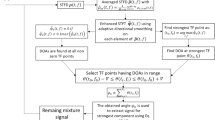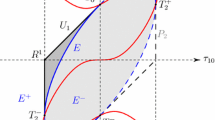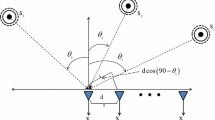Abstract
Multi-component characteristics and missing data samples introduce artifacts and cross-terms in quadratic time–frequency distributions, thus affecting their readability. In this study, we propose a new time–frequency method that employs directional smoothing and compressive sensing to reduce cross-terms and mitigate artifacts associated with missing samples. The efficacy of the proposed time–frequency distribution for solving real-life problems is illustrated by employing it to estimate direction of arrival of sparsely sampled sources in under-determined scenario. Numerical results show that the proposed method is superior to other state-of-the-art methods both in terms of obtaining clear time–frequency representation and accurately estimating direction of arrival.









Similar content being viewed by others
References
S. Ali, N. Ali Khan, M. Haneef, X. Luo, Blind source separation schemes for mono-sensor and multi-sensor systems with application to signal detection. Circuits Syst. Signal Process. 1–22 (2017). doi:10.1007/s00034-017-0533-6
N. Ali Khan, S. Ali, M. Jansson, Direction of arrival estimation using adaptive directional time–frequency distributions. Multidimens. Syst. Signal Process. 1–19 (2016). doi:10.1007/s11045-016-0435-y
M. Amin, B. Jokanovic, Y.D. Zhang, F. Ahmad, A sparsity-perspective to quadratic time–frequency distributions. Digit. Signal Process. 46, 175–190 (2015)
M. Awal, B. Boashash, An automatic fast optimization of quadratic time–frequency distribution using the hybrid genetic algorithm. Signal Process. 131, 134–142 (2017)
B. Boashash, Time-Frequency Signal Analysis and Processing: A Comprehensive Reference, 2nd edn. (Elsevier, Amsterdam, 2015)
B. Boashash, N. Khan, Taoufik Ben-Jabeur, Time–frequency features for pattern recognition using high-resolution TFDs: a tutorial review. Digit. Signal Process. 40, 1–30 (2015)
Leon Cohen, Time–Frequency Analysis: Theory and Applications (Prentice-Hall Inc, Upper Saddle River, 1995)
L. Guo, Y.D. Zhang, Q. Wu, M.G. Amin, Doa estimation of sparsely sampled nonstationary signals, in IEEE China Summit and International Conference on Signal and Information Processing (ChinaSIP), July 2015, pp. 300–304
F. Hlawatsch, G.F. Boudreaux-Bartels, Linear and quadratic time–frequency signal representations. IEEE Signal Process. Mag. 9, 21–67 (1992)
B. Jokanovic, M. Amin, Reduced interference sparse time–frequency distributions for compressed observations. IEEE Trans. Signal Process. 63, 6698–6709 (2015)
B. Jokanovic, M. Amin, T. Dogaru, Time-frequency signal representations using interpolations in joint-variable domains. IEEE Geosci. Remote Sens. Lett. 12, 204–208 (2015)
B. Jokanovic, M.G. Amin, Y.D. Zhang, F. Ahmad, Multi-window time–frequency signature reconstruction from undersampled continuous-wave radar measurements for fall detection. IET Radar Sonar Navig. 9, 173–183 (2015)
D. Jones, Richard Baraniuk, An adaptive optimal-kernel time–frequency representation. IEEE Trans. Signal Process. 43, 2361–2371 (1995)
N. Khan, B. Boashash, Multi-component instantaneous frequency estimation using locally adaptive directional time frequency distributions. Int. J. Adapt. Control Signal. Process. 30, 429–442 (2016)
H. Krim, M. Viberg, Two decades of array signal processing research: the parametric approach. IEEE Signal Process. Mag. 13(4), 67–94 (1996)
M. Mohammadi, A. Akbar Pouyan, N. Ali Khan, A highly adaptive directional time-frequency distribution. Signal Image Video Process. 10(7), 1369–1376 (2016)
W. Mu, M.G. Amin, Y. Zhang, Bilinear signal synthesis in array processing. IEEE Trans. Signal Process. 51(1), 90–100 (2003)
S. Nicoletta, I. Orovic, V. Sucic, Optimization of quadratic time–frequency distributions using the local Renyi entropy information. Signal Process. 129, 17–24 (2016)
I. Orovic, A. Draganic, S. Stankovic, Sparse time–frequency representation for signals with fast varying instantaneous frequency. IET Radar Sonar Navig. 9, 1260–1267 (2015)
L. Rankine, M. Mesbah, B. Boashash, IF estimation for multicomponent signals using image processing techniques in the time–frequency domain. Signal Process. 87(6), 1234–1250 (2007)
L. Stankovic, A measure of some time–frequency distributions concentration. Signal Process. 81, 621–631 (2001)
L. Stankovic, S. Stankovic, I. Orovic, Y.D. Zhang, Time-Frequency Analysis of Micro-Doppler Signals Based on Compressive Sensing, chapter 9 (CRC Press, Boca Raton, 2014)
B.L. Sturm, M. Grœsb, et al., Comparison of orthogonal matching pursuit implementations, in2012 Proceedings of the 20th European IEEE, 2012 Signal Processing Conference (EUSIPCO), pp. 220–224
H.L. Van Trees, Optimum Array Processing (Wiley Interscience, New York, 2002)
J.A. Tropp, Anna Gilbert, Signal recovery from random measurements via orthogonal matching pursuit. IEEE Trans. Inf. Theory 53, 4655–4666 (2007)
Y. Yang, X. Dong, Z. Peng, W. Zhang, Guang Meng, Component extraction for non-stationary multi-component signal using parameterized de-chirping and band-pass filter. IEEE Signal Process. Lett. 22(9), 1373–1377 (2015)
Y. Zhang, M.G. Amin, B. Himed, Reduced interference time-frequency representations and sparse reconstruction of undersampled data., in Proceeedings of the European Signal Processing Conference, Marrakech, Morocco, 2013
Y.D. Zhang, M.G. Amin, B. Wang, Mitigation of sparsely sampled nonstationary jammers for multi-antenna gnss receivers, in 2016 IEEE International Conference on IEEE, 2016 Acoustics, Speech and Signal Processing (ICASSP), pp. 6565–6569
Author information
Authors and Affiliations
Corresponding author
Rights and permissions
About this article
Cite this article
Ali Khan, N., Ali, S. Sparsity-Aware Adaptive Directional Time–Frequency Distribution for Source Localization. Circuits Syst Signal Process 37, 1223–1242 (2018). https://doi.org/10.1007/s00034-017-0603-9
Received:
Revised:
Accepted:
Published:
Issue Date:
DOI: https://doi.org/10.1007/s00034-017-0603-9




